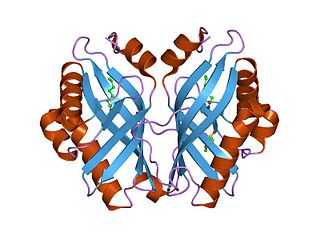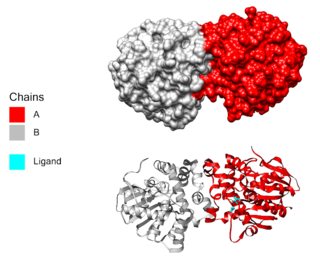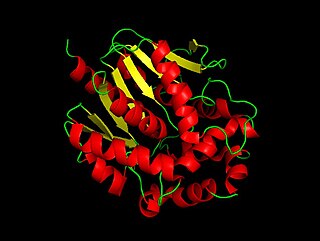Cometabolism is defined as the simultaneous degradation of two compounds, in which the degradation of the second compound depends on the presence of the first compound. This is in contrast to simultaneous catabolism, where each substrate is catabolized concomitantly by different enzymes. Cometabolism occurs when an enzyme produced by an organism to catalyze the degradation of its growth-substrate to derive energy and carbon from it is also capable of degrading additional compounds. The fortuitous degradation of these additional compounds does not support the growth of the bacteria, and some of these compounds can even be toxic in certain concentrations to the bacteria.

In biochemistry, glycoside hydrolases are a class of enzymes which catalyze the hydrolysis of glycosidic bonds in complex sugars. They are extremely common enzymes, with roles in nature including degradation of biomass such as cellulose (cellulase), hemicellulose, and starch (amylase), in anti-bacterial defense strategies, in pathogenesis mechanisms and in normal cellular function. Together with glycosyltransferases, glycosidases form the major catalytic machinery for the synthesis and breakage of glycosidic bonds.
Paenarthrobacter ureafaciens KI72, popularly known as nylon-eating bacteria, is a strain of Paenarthrobacter ureafaciens that can digest certain by-products of nylon 6 manufacture. It uses a set of enzymes to digest nylon, popularly known as nylonase.

Nitisinone, sold under the brand name Orfadin among others, is a medication used to slow the effects of hereditary tyrosinemia type 1 (HT-1).
In enzymology, a cyclohexane-1,2-diol dehydrogenase (EC 1.1.1.174) is an enzyme that catalyzes the chemical reaction
In enzymology, a 3-hydroxycyclohexanone dehydrogenase is an enzyme that catalyzes the chemical reaction

In enzymology, a limonene-1,2-epoxide hydrolase (EC 3.3.2.8) is an enzyme that catalyzes the chemical reaction
In enzymology, a beta-diketone hydrolase (EC 3.7.1.7) is an enzyme that catalyzes the chemical reaction
In enzymology, a cyclohexane-1,3-dione hydrolase (EC 3.7.1.10) is an enzyme that catalyzes the chemical reaction

In enzymology, a haloacetate dehalogenase (EC 3.8.1.3) is an enzyme that catalyzes the chemical reaction

In enzymology, a haloalkane dehalogenase (EC 3.8.1.5) is an enzyme that catalyzes the chemical reaction
In enzymology, a (S)-2-haloacid dehalogenase (EC 3.8.1.2) is an enzyme that catalyzes the chemical reaction

The enzyme α-L-fucosidase (EC 3.2.1.51) catalyzes the following chemical reaction: an α-L-fucoside + H2O L-fucose + an alcohol

In enzymology, a glucosylceramidase (EC 3.2.1.45) is an enzyme that catalyzes the chemical reaction
In enzymology, a 6-aminohexanoate-cyclic-dimer hydrolase (EC 3.5.2.12) is an enzyme that catalyzes the chemical reaction
A ureohydrolase is a type of hydrolase enzyme. The ureohydrolase superfamily includes arginase, agmatinase, formiminoglutamase and proclavaminate amidinohydrolase. These enzymes share a 3-layer alpha-beta-alpha structure, and play important roles in arginine/agmatine metabolism, the urea cycle, histidine degradation, and other pathways.
In molecular biology, glycoside hydrolase family 92 is a family of glycoside hydrolases.
6-oxocamphor hydrolase (EC 3.7.1.18, OCH, camK (gene)) is an enzyme with systematic name bornane-2,6-dione hydrolase. This enzyme catalyses the following chemical reaction

Cyclohexane-1,2-diol is a chemical compound found in castoreum. It can exist in either cis- or trans-isomers.
Ideonella sakaiensis is a bacterium from the genus Ideonella and family Comamonadaceae capable of breaking down and consuming the plastic polyethylene terephthalate (PET) using it as both a carbon and energy source. The bacterium was originally isolated from a sediment sample taken outside of a plastic bottle recycling facility in Sakai City, Japan.








